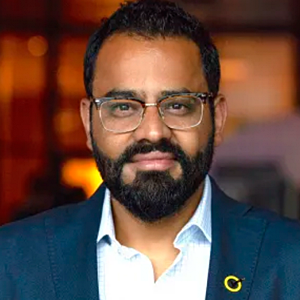Q1. Cybersecurity spending has kept steadily increasingly recently yet most enterprise organizations appear to be as vulnerable to security threats as they were a few years ago. What are they doing wrong, or not enough of?
Let's put this into an even starker perspective. In the last seven years, more than $1 trillion has been spent on cybersecurity with a 95% success rate – for the attackers. It isn't surprising that every CISO I speak to today doesn't feel any safer. And when we spend the next $1 trillion should we expect a different result?
The challenge organizations are facing today is in their race to take advantage of the $100 trillion competitive advantage that digital transformation represents, security architectures are breaking. Many organizations today are still operating within an infrastructure-centric security approach that has not kept pace with the rate of change that digital transformation requires.
Business and security leaders, and Boards of Directors, are realizing their organizations can't just spend their way out of the problem – even when security budgets are reportedly up 9%.
If you take a look at how security is applied in an infrastructure-centric paradigm, policies are applied from the infrastructure to groups, or departments or to the whole company. This results in security friction for employees and creates an opportunity for malicious actors to exploit loopholes in the policy or the rights that are applied. Due to the generic nature of these policies, the noise of events and log files makes finding the bad amongst the good extremely difficult.
Organizations today need to rethink their security posture, and look at it from an inside-out approach. Meaning, in today's mobile and cloud-first business environment users and data must be at the center of security design thinking. By making humans, and not events, the units of analysis, security teams can use events as data input to understand what each individual is trying to do by their behavior.
Based on that understanding, different policies can be applied to each digital identity based on the riskiness of that behavior. You can now get aggressive with automation to stop threats without breaking the environment. This one-to-one proactive security approach provides more user freedom and proportional security enforcement based on a dynamic risk-adaptive profile.
This is the disruptive thinking needed to mitigate risks in today's sophisticated threat landscape. And those organizations that embrace this modern cybersecurity approach will be the ones who can also drive significant business success through their digital transformation journey and beyond.
Q2. Enterprise interest in zero-trust security models appears to be growing. How can Forcepoint's human-centric approach help organizations enable a zero-trust model?
Introduced in 2010, the Zero Trust concept was one of the first times the industry started a conversation outside of the traditional model of "trust but verify" shifting instead to "never trust, always verify". Over the years this philosophy has evolved as the cybersecurity threat has matured. Yet it still exists closely within its original architecture, which utilizes a range of different technologies and best practices centered around identity verification.
Forcepoint's human-centric approach to security takes zero-trust one step-further.
Through our risk-adaptive security model we see an opportunity to enable connected trust. Meaning, for businesses and governments to flourish within today's digital transformation landscape, some level of trust is required. And in this context, levels of trust are nuanced based on the organization and its definition of what is considered acceptable risk.
To establish connected trust, understanding of human behavior and intent is critical. Creating a baseline understanding of all "normal" behavior of digital identities on a network enables faster identification and classification of outlier and risky behavior. In this model, anonymized digital identities that deviate from their "normal" behavioral patterns trigger an alert that security administrators can react to quickly, as well as a relevant automated enforcement response based on the identity's elevated risk score.
As a result, security teams also know exactly where the problem lies—with a specific digital identity—and can focus automated enforcement efforts on observing or blocking specific activities based on the level of risk the activity represents. And, important for security teams inundated with alert fatigue, this automation in enforcement increases [speed] and requires less human interaction. Monitoring each user's behavioral patterns—and streamlining security response to only those incidents that exhibit anomalies in baseline patterns—also helps keep systems secure without penalizing everyone. This enables a one-to-one security approach versus the one-to-many approach organizations have historically utilized.
Ultimately, Forcepoint views trust as a continuum between zero and permissive, and to be effective against today's threats modern security needs to be more personalized, while allowing people to still be productive and work unencumbered by security friction.
Q3. What are Forcepoint's plans at Black Hat USA 2019? What can attendees expect to hear from your company at the event?
As digital transformation reshapes industries, organizations of all sizes and across industries are rethinking their approach to innovation and how technology can help them compete more effectively. Black Hat attendees can visit Forcepoint Booth #622 to learn more about our newest security capabilities coming later this year to accelerate digital transformation, such as Forcepoint Dynamic Edge Protection.
Dynamic Edge Protection delivers an integrated network security solution that supports modernization of enterprise networks for cloud adoption. It does this by enabling enterprises to transform their network and security architectures with seamless connectivity to take full advantage of the cloud across distributed application and network environments. The solution will also offer converged capabilities for SD-WAN connectivity and next-generation firewall-as-a-service with security for Web and Cloud – all as a cloud-first, hybrid-ready service using Forcepoint's enterprise grade technologies.
Dynamic Edge Protection will deliver security that works everywhere employees are with solutions delivered from the cloud that take advantage of new advances such as behavior-centric, risk-adaptive security without on-site updates or redeployment.
Highly distributed organizations such as retailers, financial institutions, hospitality providers, and government agencies can use Forcepoint Dynamic Edge Protection to significantly reduce the cost and complexity of connecting their hundreds or thousands of remote locations in a highly secure and manageable way. The solution's "zero footprint" can also replace disparate hardware appliances deployed at each site with integrated, behavior-centric security services delivered from the cloud.
Black Hat attendees can also join Forcepoint experts in our booth for theater presentations and hands-on demos including our Risk-Adaptive Data Protection solutions, Web Security incorporating CASB capabilities, human-aware NGFW and cross-domain solutions.
We're moving fast to change the cybersecurity industry and we're also looking for the best talent to join us. Our recruiters will be at booth #CZ102 in the Career Zone to answer questions from anyone who'd like to learn more about job opportunities at Forcepoint.








